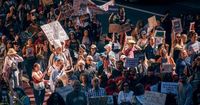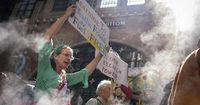On September 20, 2025, New York City’s streets pulsed with the energy of thousands of activists, families, and everyday New Yorkers determined to send a message that echoed far beyond the city’s iconic skyline. As the eve of New York Climate Week arrived, demonstrators gathered in a sprawling march down Park Avenue, weaving past luxury storefronts, and ultimately converging near Trump Tower on Billionaires’ Row. Their rallying cry? To “Make Billionaires Pay”—a demand for climate justice, democracy, gender equality, free speech, an end to Trump’s immigration crackdown, and a ceasefire in Gaza.
According to the Associated Press, the protest was as much a spectacle as it was a statement. Activists and members of the public called out the financial institutions and elite individuals they claimed were “profiting” from the climate crisis and ongoing wars. The demonstration was one of many planned around the globe ahead of the United Nations General Assembly and the high-profile events of New York Climate Week.
The diversity of causes represented was striking. Protesters’ signs and chants reflected a wide spectrum of grievances and aspirations. But as many participants explained, the issues felt deeply interconnected. “I don’t see them as movements. I don’t see them as organizations. I just see humanity. We are all on this Earth. This is our mother,” said Mahaishuwea, whose name means Eagle Woman in the Hidatsa language, as reported by NBC News. She spoke about her upbringing on the Fort Berthold Indian reservation in North Dakota, where she survived cancer, and drew a direct line from the violent history of colonization and resource extraction on Indigenous lands to what she described as the present-day greed of the powerful. “They have a sickness,” she said, standing in front of Blackstone’s headquarters, a symbol for many of the financial interests under protest.
As the marchers pressed on, the crowd stretched for more than four city blocks, passing by the glittering displays of Louis Vuitton, Bergdorf Goodman, and Tiffany & Co. The mood was both festive and defiant. Some activists carried enormous papier-mâché puppets depicting tech billionaires Elon Musk, Jeff Bezos, and Mark Zuckerberg—a playful yet pointed jab at those seen as emblematic of wealth and influence. Others grabbed the edges of a 160-foot-long “climate polluters bill,” a dramatic prop highlighting the economic damages wrought by extreme weather events, damages that many attribute to the carbon emissions of major polluting companies.
The creativity didn’t stop there. Protesters dressed as the Statue of Liberty, rang cowbells, and waved flags emblazoned with Princess Leia from Star Wars. Homemade signs, scrawled in sharpie and paint, added to the colorful tapestry of dissent. One sign simply read: “Free Kimmel.”
Yet for many, the spectacle masked deeper, more personal stories. Tatiana Cruz, who helped hold up the puppet of Elon Musk, summed up the mood with a smile: “Eat the rich, that’s the main message.” But her journey to activism was rooted in heartache. “This was my first year actively protesting more after two of my friends were deported after being detained by U.S. Immigration and Customs Enforcement,” she explained. Since then, Cruz has become involved in movements for migrant rights, Palestinian liberation, and the fight against climate change. “The monster up top is similar in a lot of different scenarios,” she said, capturing the sense of a common adversary.
Julia Donahue-Wait, who traveled from the South Bronx with a group of families, described how the march felt like an act of collective empowerment. Her six-year-old daughter, Eurydice, has grown up on picket lines and helped paint posters for the event. “It’s all people without power taking it back,” Donahue-Wait told NBC News. “What we say to the kids is, we have safety and we need to stand up for people who don’t have safety.” Behind her, a protester held a sign that read: “Our work is love.”
As the march neared its end, participants gathered in front of the Trump International Hotel and Tower for a solemn five-minute moment of silence. The gesture was a powerful pause—an opportunity to reflect on the gravity of the issues at hand and the solidarity among those assembled.
This year’s demonstration took on added urgency, as 2024 had been officially declared the hottest year on record, according to NBC News. Despite years of international conferences, negotiations, and treaties, countries around the world have continued to increase emissions of carbon dioxide and other greenhouse gases, fueling more frequent and intense extreme weather events. The Trump administration’s efforts to roll back foundational environmental rules have only heightened concerns. These policy changes, critics argue, have paved the way for greater pollution by oil and coal industries and created new obstacles for the development of wind and solar energy.
Tamika Middleton, managing director of the Women’s March, acknowledged that uniting people across so many causes can be a challenge. This year, however, the connections between climate, economic justice, and immigrant rights felt especially clear. “The climate crisis, economic fights and immigrant fights are all really one big fight,” she said.
It’s a sentiment echoed by many on the streets that day. The protest was more than a climate rally—it was a convergence of intersecting struggles, each woven into the fabric of the march. Activists linked the climate crisis to economic inequality, racial justice, and the ongoing fight for democracy. The presence of Indigenous voices underscored the long shadow cast by colonization and resource extraction, while families and children reminded onlookers that the stakes reach into the next generation.
Even as the crowd dispersed, the message lingered. Mahaishuwea, reflecting on the fear and uncertainty many feel, insisted on the importance of showing up. “To show people we’re not afraid,” she said. Her 12-year-old daughter was at home, but Mahaishuwea hoped her example would teach future generations how to speak up.
With the United Nations General Assembly and New York Climate Week set to dominate headlines, the protest’s timing was no accident. Organizers and participants alike sought to put pressure on world leaders and financial institutions, demanding accountability and action in the face of growing crises. Their voices—diverse, passionate, and insistent—served as a reminder that the fight for climate justice is inseparable from broader battles for equity, safety, and dignity.
As the city returned to its usual rhythm, the echoes of chants, cowbells, and hopeful calls for change lingered in the air, a testament to the power of collective action and the promise that, when people come together, even the mightiest towers can be challenged.





